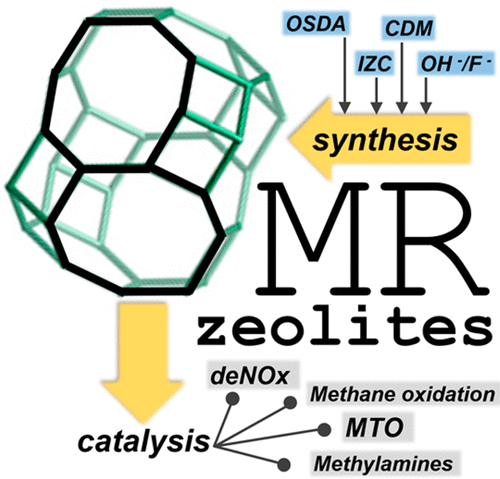当前位置:
X-MOL 学术
›
Chem. Rev.
›
论文详情
Our official English website, www.x-mol.net, welcomes your
feedback! (Note: you will need to create a separate account there.)
Small-Pore Zeolites: Synthesis and Catalysis
Chemical Reviews ( IF 51.4 ) Pub Date : 2018-05-10 00:00:00 , DOI: 10.1021/acs.chemrev.7b00738 Michiel Dusselier 1 , Mark E. Davis 2
Chemical Reviews ( IF 51.4 ) Pub Date : 2018-05-10 00:00:00 , DOI: 10.1021/acs.chemrev.7b00738 Michiel Dusselier 1 , Mark E. Davis 2
Affiliation

|
In the past decade or so, small-pore zeolites have received greater attention than large- and medium-pore molecular sieves that have historically dominated the literature. This is primarily due to the commercialization of two major catalytic processes, NOx exhaust removal and methanol conversion to light olefins, that take advantage of the properties of these materials with smaller apertures. Small-pore zeolites possess pores that are constructed of eight tetrahedral atoms (Si4+ and Al3+), each time linked by a shared oxygen These eight-member ring pores (8MR) provide small molecules access to the intracrystalline void space, e.g., to NOx during car exhaust cleaning (NOx removal) or to methanol en route to its conversion into light olefins, while restricting larger molecule entrance and departure that is critical to overall catalyst performance. In total, there are forty-four structurally different small-pore zeolites. Forty-one of these zeolites can be synthesized, and the first synthetic zeolite (KFI, 1948) was in fact a small-pore material. Although the field of 8MR zeolite chemistry has expanded in many directions, the progress in synthesis is framework-specific, leaving insights and generalizations difficult to realize. This review first focuses on the relevant synthesis details of all 8MR zeolites and provides some generalized findings and related insights. Next, catalytic applications where 8MR zeolites either have been commercialized or have dominated investigations are presented, with the aim of providing structure–activity relationships. The review ends with a summary that discusses (i) both synthetic and catalytic progress, (ii) a list of opportunities in the 8MR zeolite field, and (iii) a brief future outlook.
中文翻译:

小孔沸石:合成与催化
在过去的十年左右的时间里,小孔沸石受到了历史上一直占据主导地位的大孔和中孔分子筛的关注。这主要是由于两个主要的催化工艺的商业化,即NOx排气去除和甲醇转化为轻质烯烃,它们利用了孔径较小的这些材料的特性。小孔沸石具有由八个四面体原子(Si 4+和Al 3+),每次由共享的氧气连接。这些八元环孔(8MR)提供小分子进入晶体内空隙的空间,例如,在汽车排气清洁(去除NOx)过程中的NOx或在转化为光的途中的甲醇烯烃,同时限制了对整体催化剂性能至关重要的较大分子的进入和离开。总共有四十四种结构不同的小孔沸石。这些沸石中有41种可以合成,而第一种合成沸石(KFI,1948年)实际上是一种小孔材料。尽管8MR沸石化学领域已向多个方向扩展,但合成方面的进展是特定于框架的,因此难以实现见识和概括。这篇综述首先关注所有8MR沸石的相关合成细节,并提供一些概括性发现和相关见解。接下来,介绍了8MR沸石已经商业化或主导研究的催化应用,目的是提供结构-活性关系。审查的结尾是总结,讨论了(i)合成和催化方面的进展,(ii)8MR沸石领域的机会清单,以及(iii)简短的未来展望。
更新日期:2018-05-10
中文翻译:

小孔沸石:合成与催化
在过去的十年左右的时间里,小孔沸石受到了历史上一直占据主导地位的大孔和中孔分子筛的关注。这主要是由于两个主要的催化工艺的商业化,即NOx排气去除和甲醇转化为轻质烯烃,它们利用了孔径较小的这些材料的特性。小孔沸石具有由八个四面体原子(Si 4+和Al 3+),每次由共享的氧气连接。这些八元环孔(8MR)提供小分子进入晶体内空隙的空间,例如,在汽车排气清洁(去除NOx)过程中的NOx或在转化为光的途中的甲醇烯烃,同时限制了对整体催化剂性能至关重要的较大分子的进入和离开。总共有四十四种结构不同的小孔沸石。这些沸石中有41种可以合成,而第一种合成沸石(KFI,1948年)实际上是一种小孔材料。尽管8MR沸石化学领域已向多个方向扩展,但合成方面的进展是特定于框架的,因此难以实现见识和概括。这篇综述首先关注所有8MR沸石的相关合成细节,并提供一些概括性发现和相关见解。接下来,介绍了8MR沸石已经商业化或主导研究的催化应用,目的是提供结构-活性关系。审查的结尾是总结,讨论了(i)合成和催化方面的进展,(ii)8MR沸石领域的机会清单,以及(iii)简短的未来展望。











































 京公网安备 11010802027423号
京公网安备 11010802027423号